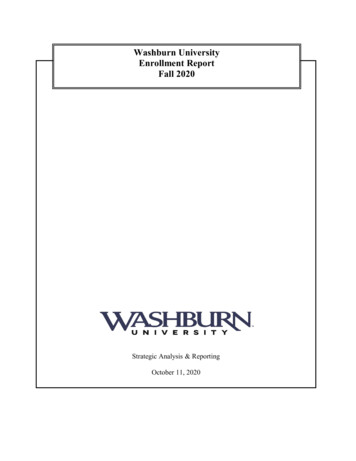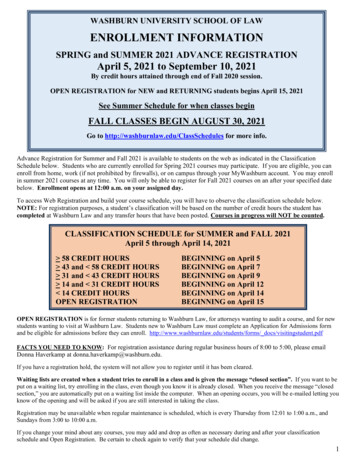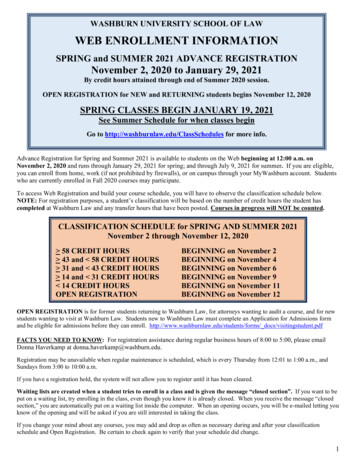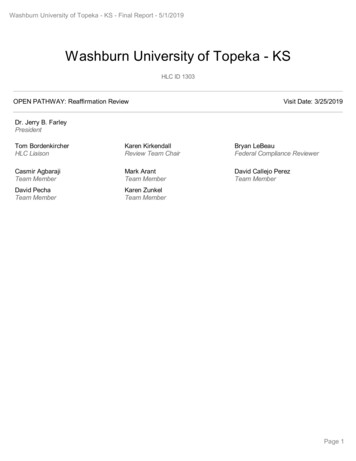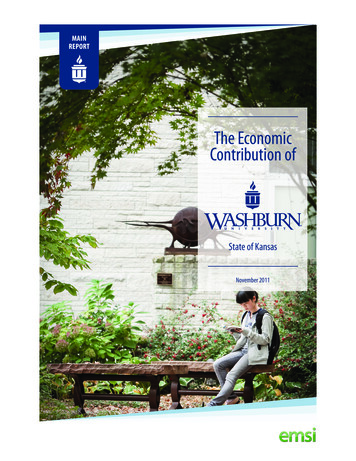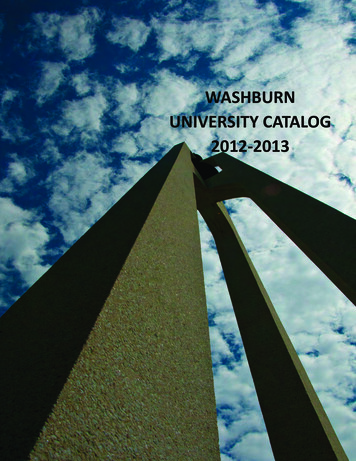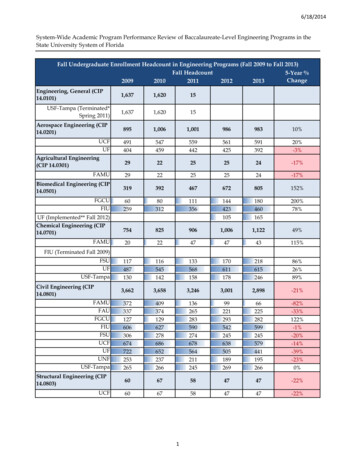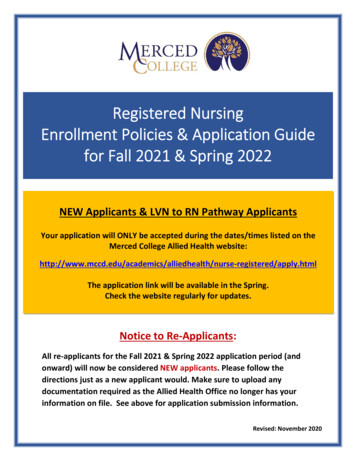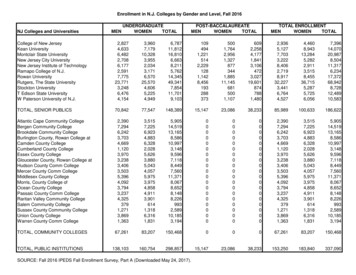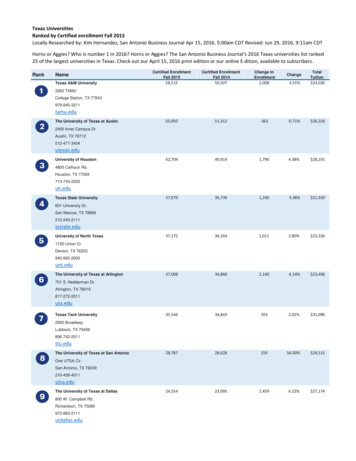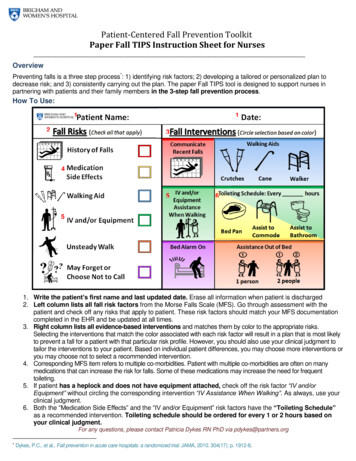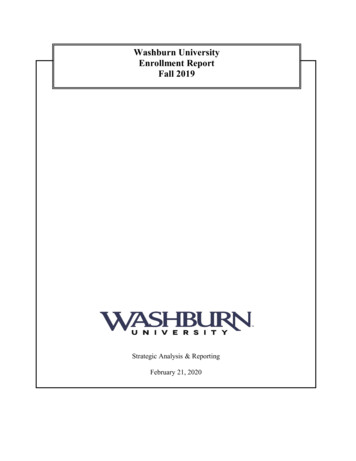
Transcription
Washburn UniversityEnrollment ReportFall 2019Strategic Analysis & ReportingFebruary 21, 2020
1The Fall 2019 Enrollment Report provides information about headcount and student credit hourenrollment for Washburn University (Washburn) and Washburn University Institute of Technology(Washburn Tech), based on each campus’s 20th day census snapshot. Appendix A (pp. 19) provides fallheadcount enrollment for the six public four-year Kansas institutions, the community colleges, andtechnical schools.Tables 1, 5, 6, 9, 11, and 12, as well as Appendix A, and Graphs 1 and 2 (pp. 7-8, 12-14, 17, 19-20, 29)either provide headcount and credit hour comparisons between Fall 2018 and Fall 2019 or describe thecharacteristics of Fall 2019 students. Tables 2, 3, 4, 7, 8, and 10 (pp. 9-11, 15-16, 19) provide longitudinaltrends documenting headcount and credit hour changes.Supplementary Tables 1, 2, 5-7 (pp. 21-22, 25-27) provide snapshot data between 2010 and 2019, whileTables 3 and 4 (pp. 23-24) provide data between 2010 and 2019, documenting headcount and credit hourchanges for each of the types of students – defined in the main body below -- who enroll at Washburnand their demographic and academic characteristics as of the 20th day snapshot. Supplementary Table 8(pp. 28) documents how the number of credit hours at each college or school – in lower and upper divisioncourses as well as graduate courses – have changed between 2010 and 2019.Executive Summary Overall Washburn headcount enrollment decreased 286 students to 6,285 in Fall 2019 from theFall 2018 semester’s 6,571, or 4.4%. Credit hours decreased 3,224, or 4.5%, going from 71,883 inFall 2018 to 68,659 in Fall 2019. FTE decreased from 4,931 to 4,710, or 4.5%. See Table 1. When excluding high school students, overall headcount enrollment decreased 266 students fromFall 2018, or 2.2%. Credit hours decreased 1,707, a 2.5% drop. See Figures 1 and 2. Overall degree-seeking undergraduate headcount enrollment decreased in Fall 2019 to 4,567from the Fall 2018 semester enrollment of 4,765 , a 4.2% decrease. Credit hours decreased 2,808,a 4.4% decline. See Table 1 and Supplementary Table 8.oFirst-time freshmen headcount decreased to 788 students from the Fall 2018 semester’s791 headcount, a 0.4% decrease. Credit hours increased 0.5% for first-time freshmen.Direct from high school first-time freshmen headcount increased to 732 students fromthe Fall 2018 headcount of 729, a 0.4% increase. Credit hours increased 1.7%. See “Directfrom High School” in Supplementary Table 1.oOther first-time freshmen headcount decreased by 6 students, a 9.6% decrease, andcredit hours decreased 15.1%. See “Other first-time freshmen” in Supplementary Table1 and also Table 1.oTransfer student headcount decreased 5.0%, falling from 543 students in Fall 2018 to 516students in Fall 2019. Credit hours decreased 5.0%. See Supplementary Table 2.oReturning undergraduate student headcount decreased by 10 students from Fall 2018 toFall 2019, a decrease of 4.5%. See Supplementary Table 3.Fall 2019 Enrollment ReportStrategic Analysis & ReportingWashburn University
2o The Fall 2019 continuing undergraduate headcount population decreased 160 studentsfrom Fall 2018, a decline of 5.0%. Credit hours increased 11.4%. See Supplementary Table4.Overall, non-law degree-seeking graduate student headcount enrollment decreased 5.4%,declining from 539 students to 510. Credit hours decreased 4.9%. See Supplementary Table 5.oThe incoming graduate student count decreased by 1 student and increased by 84.5 credithours, year over year.oThe continuing and transferring graduate student population decreased 7.7%, or 28students, and credit hours decreased 10.7%.Overall, law student headcount enrollment decreased by 10 students from Fall 2018 to Fall 2019.Law students took 138 fewer credit hours in Fall 2019 compared to Fall 2018. See SupplementaryTable 5.oThe first-time law student population decreased by 5 students and 96 fall SCH.oThe continuing and transferring law student population decreased by 5 students, and theFall 2019 students generated 42 fewer credit hours than in Fall 2018, a 1.3% decrease.The non-degree-seeking student population and the credit hours they generated decreased in Fall2019 compared to Fall 2018. See Supplementary Table 7.oThe high school population decreased by 20 students between Fall 2018 and Fall 2019, a2.4% decrease in enrollment. High school credit hours decreased 4.5% between Fall 2018and Fall 2019.oThe non-degree-seeking undergraduate student population decreased 23.9% betweenFall 2018 and Fall 2019, falling from 109 students to 83. These students generated 24.8%fewer credit hours in Fall 2019 compared to Fall 2018, a decline of 187 credit hours.oThe non-degree-seeking graduate student population decreased by 3 students, from 8students in Fall 2018 to 5 in Fall 2019. These students generated 11 fewer hours in Fall2019, declining from 38 credit hours in Fall 2018 to 27 in Fall 2019. The 65 and over auditor population increased from 230 students in Fall 2018 to 231 students inFall 2019. See Table 1. Washburn Tech’s total headcount enrollment increased 63 students between Fall 2018 and Fall2019, a 4.4% increase. Washburn Tech’s credit hour production increased 882 credit hours, a4.9% increase. See Tables 11 and 12.Fall 2019 Enrollment ReportStrategic Analysis & ReportingWashburn University
3 Headcount enrollment at the six four-year public universities combined increased 0.1% betweenFall 2018 and Fall 2019, whereas community colleges declined 3.1%, and technical colleges grew5.7%. See Appendix A.Ten Year TrendsThis section provides ten-year trends (2010-2019) for headcount populations and credit hour generation.Washburn University’s Overall Headcount and Credit HoursFigures 1 and 2 document changes in Washburn’s enrollment for the past ten years (2010-2019) for totalheadcount and credit hour enrollment when including and excluding high school students.Figure 1: Fall Enrollment Headcount, 2010 - 550050002010201120122013Total HeadcountFall 2019 Enrollment ReportStrategic Analysis & ReportingWashburn University2014201520162017Total Headcount Excluding HS Students20182019
4Figure 2: Fall Credit Hours, 2010 - Total SCH201420152016201720182019Total SCH Excluding HS SCHUndergraduate LevelWashburn’s undergraduate level is composed of first-time freshmen, incoming transfer students,returning undergraduates (i.e., students who were enrolled, stepped out for a semester – excludingsummer -- or more, and re-enrolled), and continuing undergraduates. All first-time freshmen, newtransfer students, and returning students immediately become continuing undergraduates uponsuccessful registration in the next semester. This section provides ten years of headcount trendinformation. For more information about each population’s demographic and academic characteristics,please refer to Supplementary Tables 1-4 (pp. 21-24).First-time FreshmenFirst-time freshmen are composed of students who matriculate to Washburn directly out of high schooland students who take a year or more off of their formal education between high school graduation andtheir postsecondary matriculation to Washburn (other first-time freshmen).Supplementary Table 1 shows how these groups have changed since 2010. First-time freshmen whomatriculate directly out of high school have increased 16.5% since 2010.The other type of first-time freshmen – who average 24.71 years of age – has declined 70.6% since 2010.See Supplementary Table 1 for the demographic and academic characteristics of these students.Undergraduate Transfer StudentsThere have been dramatic year-over-year variations in the number of transfer students coming toWashburn. Overall, since 2010, the incoming transfer student population has decreased 20.1%, or 130students. Supplementary Table 2 shows how undergraduate transfer students have changed since 2010.Fall 2019 Enrollment ReportStrategic Analysis & ReportingWashburn University
5Returning StudentsSupplementary Table 3 shows how returning undergraduate students have changed since 2010.Overall, these students have declined 40.9% since 2010.Continuing Undergraduate StudentsThe size of any current continuing undergraduate student population is dependent on two factors: (1) thesize of the previous semesters’ incoming classes (i.e., first-time freshmen and transfers) as well as the sizeof the returning and continuing student populations and (2) those classes’ return rates. SupplementaryTable 4 shows how the continuing undergraduate population has changed since 2010.Overall, the size of the continuing student population has declined 17.8%, or 662 students, since Fall 2010.Graduate LevelGraduate students are composed of first-time graduate students and continuing (or new transfer)graduate students. Supplementary Table 5 shows how these populations have changed since 2010. 1The number of first-time graduate students has increased since 2010. Since then, the first-time graduatestudent population has increased by 90 students, and credit hour production has increased by 805.5 credithours.The continuing (and transferring) graduate headcount has decreased by 16 students since Fall 2010, an18.6% decrease.Law SchoolWashburn Law School is composed of first-time law students, new transfer law students, and continuinglaw students. Supplementary Table 6 shows how these populations have changed since 2010.First-time law students have declined 39.6% since Fall 2010; however, the headcount has been between80 and 89 each fall semester since 2015.Continuing and transferring law students have decreased 31.0% since 2010; however, these numbers havevaried only slightly (i.e., between 223 and 216) since Fall 2015.Non-Degree-Seeking StudentsNon-degree-seeking students include high school students enrolled for Washburn credit as well asundergraduate and graduate students who are enrolled in credit hours but who are not pursuing a degree.Supplementary Table 7 shows how these populations have changed since 2010.High school students have grown dramatically since 2010 when 488 high school students were enrolled.In Fall 2019, Washburn enrolled over one and a half times that number: 818 students. Since high schoolstudents began enrolling in higher numbers in Fall 2010, Washburn’s high school population has grown67.6%, from 488 students to 818 as of Fall 2019.Beginning with the Spring 2017 semester, Washburn introduced a way to track graduate students who transfer toWashburn from other graduate programs. When, in a few years, trend data becomes available, these students willbe separated from the continuing graduate student population.1Fall 2019 Enrollment ReportStrategic Analysis & ReportingWashburn University
6The undergraduate non-degree headcount has declined 51.7% since Fall 2010, a total loss of 89 students.The graduate non-degree headcount has declined in the last ten years. In Fall 2010, 15 students wereenrolled, and in Fall 2019, 5 students were enrolled. The peak was 24 students in Fall 2012.Credit Hours by College/SchoolSupplementary Table 8 tracks credit hours generated by each college/school at Washburn since 2010.Overall, Washburn’s credit hours have decreased 12.9% since 2010. When excluding credit hoursproduced by high school students, Washburn’s credit hours have decreased 15.4%.Since Fall 2010, the following colleges/schools have increased credit hours production: School of Nursing (15.5%)VPAA/Other (96.0%)The following colleges/schools have decreased credit hours production: College of Arts & Sciences (-19.8%)School of Applied Studies (-2.9%)School of Business (-9/6%)School of Law (-36.3%)Credit hour production decreased at the following course levels: Lower Division courses (-7.3%)o When excluding high school students, there is negative growth (-11.8%)Upper Division courses (-3.0%)Graduate and Law (-18.1%)Credit hour production increased at the following course levels: Non-Law Graduate courses (21.9%)Fall 2019 Enrollment ReportStrategic Analysis & ReportingWashburn University
7Table 1Washburn UniversityEnrollment SummaryFall 2019Total HeadcountTotal Student Credit HoursChangeNPercentFall 2019Fall l FTE4,7104,931-221-4.5%Headcount by Student ClassificationFirst-time freshmen direct high schoolFirst-time freshmen otherSubtotal first-time freshmenOther freshmenSubtotal all freshmenSophomoresJuniorsSeniorsPostbaccalaureate undergraduatesSubtotal undergraduatesMaster'sDoctorateSubtotal graduateLawSubtotal degree-seekingHigh schoolOther non-degree seekingSubtotal non-degree seekingTotal -4.8%-4.4%Headcount by GenderMaleFemaleTotal adcount by Resident/NonresidentKansas residentNonresidentTotal 187.3%12.7%100.0%-2948-286-5.1%1.0%-4.4%Minority Enrollment [1]136121.7%Headcount by Full-time/Part-timeFull-timePart-timeTotal 730.4%-30.8%65 & Over Tuition-free Audit ProgramHeadcountStudent Credit Hours231613230886Average AgeUndergraduateGraduateLawNon-degree seeking23.235.026.417.823.335.126.418.2Average Credit HoursUndergraduateGraduateLawNon-degree seeking12.47.214.05.012.37.214.05.1[1] Student ethnicity/race is self-reported. In Fall 201, % of Washburn students provided information on their ethnicity/race; % of studentswho have reported race/ethnicity data are minorities.Source: Enrollment census file, September 14, 2018 and September 15, 2017.SAR Note: For Fall 2020 and going forward, change Minority Enrollm ent to Race/Ethnicity Dem ographics .Fall 2019 Enrollment ReportStrategic Analysis & ReportingWashburn University
8Graph 1Washburn UniversityHeadcount EnrollmentFall 2019Graph 1.2Enrollment of First-time FreshmenGraph 1.1Enrollment by Student ClassificationLaw3024.8%Direct from High SchoolFull-timeSource: Enrollment census files.Fall 2019 Enrollment ReportStrategic Analysis & ReportingWashburn UniversityPart-timeFall 2019Fall 2018Fall 2017TotalFall 2019Fall 2018Fall 2017Fall 2016Fall 2015Fall 2014Juniors99015.8%Fall 2013Seniors1,41822.6%Fall 2012Postbac Fall 2011Sophomores82213.1%Other FTFGraph 1.3Enrollment by Full-time/Part-time StatusFall 2010Graduate5158.2%Fall 2016Fall 2015Fall 2014Fall 2013Fall 2012First-timeFreshmen78812.5%Fall 2010High School81813.0%Other Freshmen3926.2%Fall 2011Other Nondegree831.3%9008007006005004003002001000
9Table 2Headcount Enrollment and Student Credit HoursFall 1970 to Fall 2016201720182019Full-time PercentHeadcount ChangeNANANANA3,7124,0769.8%3,316 7-3.7%4,085-4.9%Part-time PercentHeadcount 00-3.3%Total PercentHeadcount 910.8%6,571-1.8%6,285-4.4%Student PercentCredit Hours 041.5%71,883-2.1%68,659-4.5%Note: Full-time status is based on enrollment of 12 or more hours for undergraduate and 9 or more for graduate and law. Prior to fall2006, full-time status for law was based on 10 or more hours.Source: Enrollment census files.Fall 2019 Enrollment ReportStrategic Analysis & ReportingWashburn University
10Table 3Headcount by Student Classification and Full-time/Part-time StatusFall 2015 to Fall 2019Full-timePart-timeTotalFall 2015Fres hmenSophomoresJuni orsSeni orsPos tbaccal aureateSubtotal undergraduateGraduateLawNon-degree s eeki ngTotalPercent 8%74.1%7.9%4.5%13.5%100.0%Fall 2016Fres hmenSophomoresJuni orsSeni orsPos tbaccal aureateSubtotal undergraduateGraduateLawNon-degree s eeki ngTotalPercent 2.8%74.8%8.4%4.5%12.3%100.0%Fall 2017Fres hmenSophomoresJuni orsSeni orsPos tbaccal aureateSubtotal undergraduateGraduateLawNon-degree s eeki ngTotalPercent 5%73.6%7.6%4.6%14.2%100.0%Fall 2018Fres hmenSophomoresJuni orsSeni orsPos tbaccal aureateSubtotal undergraduateGraduateLawNon-degree s eeki ngTotalPercent %72.5%8.3%4.8%14.4%100.0%Fall 2019Fres hmenSophomoresJuni orsSeni orsPos tbaccal aureateSubtotal undergraduateGraduateLawNon-degree s eeki ngTotalPercent .0%19.9%3.5%46.6%14.9%0.1%38.5%
enrollment for Washburn University (Washburn) and Washburn University Institute of Technology (Washburn Tech), based on each campus’s 20th day census snapshot. Appendix A (pp. 9) provides1 fall headcount enrollment for the six public four-year Kansas ins
